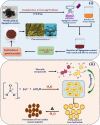Sustainable green approach to synthesize Fe3O4/α-Fe2O3 nanocomposite using waste pulp of Syzygium cumini and its application in functional stability of microbial cellulases
- PMID: 34934128
- PMCID: PMC8692407
- DOI: 10.1038/s41598-021-03776-w
Sustainable green approach to synthesize Fe3O4/α-Fe2O3 nanocomposite using waste pulp of Syzygium cumini and its application in functional stability of microbial cellulases
Abstract
Synthesis of nanomaterials following green routes have drawn much attention in recent years due to the low cost, easy and eco-friendly approaches involved therein. Therefore, the current study is focused towards the synthesis of Fe3O4/α-Fe2O3 nanocomposite using waste pulp of Jamun (Syzygium cumini) and iron nitrate as the precursor of iron in an eco-friendly way. The synthesized Fe3O4/α-Fe2O3 nanocomposite has been extensively characterized through numerous techniques to explore the physicochemical properties, including X-ray diffraction, Fourier transform infrared spectroscopy, Raman spectroscopy, Ultraviolet-Vis spectroscopy, field emission scanning electron microscope, high resolution transmission electron microscope and vibrating sample magnetometer. Further, efficiency of the Fe3O4/α-Fe2O3 nanocomposite has been evaluated to improve the incubation temperature, thermal/pH stability of the crude cellulase enzymes obtained from the lab isolate fungal strain Cladosporium cladosporioides NS2 via solid state fermentation. It is found that the presence of 0.5% Fe3O4/α-Fe2O3 nanocomposite showed optimum incubation temperature and thermal stability in the long temperature range of 50-60 °C for 15 h along with improved pH stability in the range of pH 3.5-6.0. The presented study may have potential application in bioconversion of waste biomass at high temperature and broad pH range.
© 2021. The Author(s).
Conflict of interest statement
The authors declare no competing interests.
Figures







Similar articles
-
A novel route to the synthesis of α-Fe2O3@C@SiO2/TiO2 nanocomposite from the metal-organic framework as a photocatalyst for water treatment.Chemosphere. 2022 Jun;297:133992. doi: 10.1016/j.chemosphere.2022.133992. Epub 2022 Mar 2. Chemosphere. 2022. PMID: 35247450
-
Eco-friendly synthesis of an α-Fe2O3/rGO nanocomposite and its application in high-performance asymmetric supercapacitors.Phys Chem Chem Phys. 2024 Jun 6;26(22):16273-16286. doi: 10.1039/d4cp00592a. Phys Chem Chem Phys. 2024. PMID: 38804664
-
α-Cellulose Fibers of Paper-Waste Origin Surface-Modified with Fe3O4 and Thiolated-Chitosan for Efficacious Immobilization of Laccase.Polymers (Basel). 2021 Feb 15;13(4):581. doi: 10.3390/polym13040581. Polymers (Basel). 2021. PMID: 33672000 Free PMC article.
-
Enhancement in functional stability of microbial endoglanases produced using paddy straw via treatment with manganese oxide based porous nanocomposite synthesized from mixed fruit waste.Bioresour Technol. 2023 Feb;369:128219. doi: 10.1016/j.biortech.2022.128219. Epub 2022 Nov 4. Bioresour Technol. 2023. PMID: 36343777
-
Immobilization and characterization of cellulase on hydroxy and aldehyde functionalized magnetic Fe2O3/Fe3O4 nanocomposites prepared via a novel rapid combustion process.Int J Biol Macromol. 2020 Nov 1;162:845-852. doi: 10.1016/j.ijbiomac.2020.06.209. Epub 2020 Jun 25. Int J Biol Macromol. 2020. PMID: 32592783
Cited by
-
A Hydrothermal and Combustion-Reduction Process with Polyvinyl Pyrrolidone as a Restricted Growth Agent and Galactose as a Reducing Agent for the Fabrication of Rod-like α-Fe2O3/Fe3O4 Magnetic Nanocomposites.Materials (Basel). 2025 Feb 25;18(5):1014. doi: 10.3390/ma18051014. Materials (Basel). 2025. PMID: 40077238 Free PMC article.
-
A MEMS seismometer respiratory monitor for work of breathing assessment and adventitious lung sounds detection via deep learning.Sci Rep. 2025 Mar 15;15(1):9015. doi: 10.1038/s41598-025-93011-7. Sci Rep. 2025. PMID: 40089574 Free PMC article.
-
RETRACTED: Mycosynthesis of Hematite (α-Fe2O3) Nanoparticles Using Aspergillus niger and Their Antimicrobial and Photocatalytic Activities.Bioengineering (Basel). 2022 Aug 17;9(8):397. doi: 10.3390/bioengineering9080397. Bioengineering (Basel). 2022. Retraction in: Bioengineering (Basel). 2025 Jan 22;12(2):100. doi: 10.3390/bioengineering12020100. PMID: 36004922 Free PMC article. Retracted.
-
Study on Biogenic Spindle-Shaped Iron-Oxide Nanoparticles by Pseudostaurosira trainorii in Field of Laser Desorption/Ionization Applications.Int J Mol Sci. 2022 Oct 3;23(19):11713. doi: 10.3390/ijms231911713. Int J Mol Sci. 2022. PMID: 36233015 Free PMC article.
-
Rapid Removal of Organic Pollutants from Aqueous Systems under Solar Irradiation Using ZrO2/Fe3O4 Nanoparticles.Molecules. 2022 Nov 20;27(22):8060. doi: 10.3390/molecules27228060. Molecules. 2022. PMID: 36432160 Free PMC article.
References
-
- Satari B, Karimi K, Kumar R. Cellulose solvent-based pretreatment for enhanced second-generation biofuel production: a review. Sustain. Energy Fuels. 2019;3:11–62. doi: 10.1039/C8SE00287H. - DOI
-
- Xue D, Yao D, Sukumaran RK, You X, Wei Z, Gong C. Tandem integration of aerobic fungal cellulase production, lignocellulose substrate saccharification and anaerobic ethanol fermentation by a modified gas lift bioreactor. Bioresour. Technol. 2020;302:122902. doi: 10.1016/j.biortech.2020.122902. - DOI - PubMed
-
- Liu H, Pang B, Zhao Y, Lu J, Han Y, Wang H. Comparative study of two different alkali-mechanical pretreatments of corn stover for bioethanol production. Fuel. 2018;221:21–27. doi: 10.1016/j.fuel.2018.02.088. - DOI
Publication types
LinkOut - more resources
Full Text Sources
Miscellaneous

